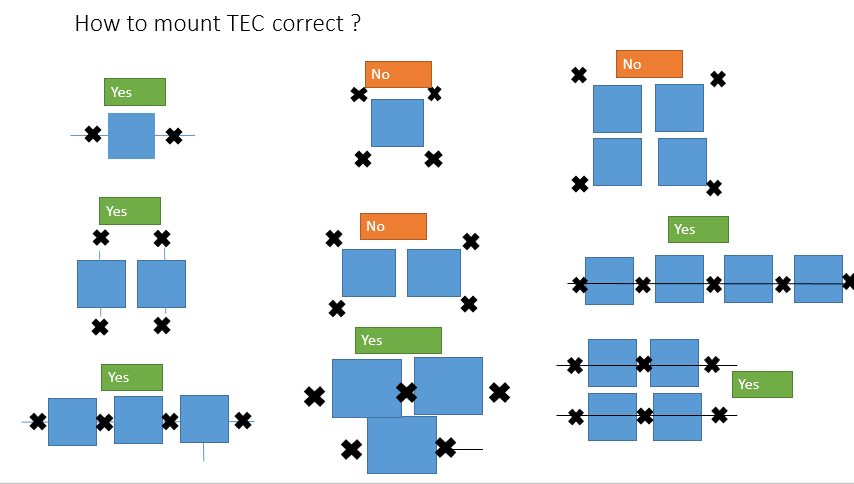How to choose a Thermal Electrical Cooler?
The following steps are required in order to select the proper Thermo Electrical cooler
- Make sure you know the ambient temperature the TEC will be working with (Th)
- Confirm the minimum cooling temperature the device should work with (Tc)
- Find out the Max Heat load power that needs to be removed (Q)
- Calculate the required cooling power that is needed including the heat loss power .This is usually determine by Qc = 1.5 Q
- Find a TEC that matches the Max Qc power needed including physical dimensions and operating Voltage and Current in the TE catalog.
- If you cannot find a desirable product consider a combination of a few smaller TEC’s that will match your requirements.
- If you need more details and confirmed calculation to find your right TEC contact us and we will do our best to meet your desired needs.
Common TEC parameters
I – Operating current of the TEC module in Amps
I – Max – Maximum operating Current that result maximum temperature difference dT
Qc – Amount of heat that can be observed at the cooling side of the TEC (in watts)
Q max -The maximum amount of heat at the cold side when I – I max and Delta T =0
Thot – Temperature at the hot side of the TEC during operation.
Tcold -Temperature at the cold side of the TEC during operation.
Delta T – The difference in temperature between hot and cold Sides.
Delta T max – The Maximum difference in temperature between hot and cold Sides at I max
U max – Voltage supply at I max.
Epsilon – TEC cooling efficiency in %
Alpha Seeback coefficient – the TEC in Voltage/Celsius
K – Thermal conductivity (w/cm*c)
N – Number of Thermoelctric elements
What you need to know before selecting Thermoelectric Assembly:
Required operating characteristics:
- Required cooling power W.
- Required inner Temperature C
Air to liquid operating parameters
- Temperature of fluid entering the fluid path
- Temperature of fluid exiting the fluid path
- Pump Pressure (Н) meter of water column
- Volume of the fluid loop, including storage tank.
- Performance m^3/hour
- Ambient Temperature C
- Relative humidity of the ambient air %
- Cabinet Volume M^3,( Length ,Width , Height)
Information on materials of the cabinet’s walls
- № of layer Type of material
- Thermal conductivity Wt/(m*К)
- Thickness, mm
Information about equipment inside the cabinet:
- Total maximum heat development of the equipment.
- Operating characteristics of the source of current (DC): Operating voltage/Amperage
Dimension parameters:
- Allowable volume to place a “cold” loop inside the cabinet
- Length, Width, Height
Conditions of the system, determining selection of passive elements of climate systems:
- Anodized heatsink at:
- Cold (inner) side
- Hot (outer) side
- Waterproof, dust-protected fan (IP 55) of the outer loop/inner loop
- Waterproof, dust-protected connectors
Conditions of the system in reverse mode, determining the selection of active elements of climate systems:
- Necessary (permissible) temperature of heating of one of the circuits up to 90 C , 110c 150c, 180c
Special requirements of the thermoelectric assembly:
- Required lifetime of the fans to failure
- Required lifetime of the assembly in ON/OFF mode
- Need of controller.
- Economic parameters:
- Projected quantity, target price
Clamping , Bonding , Soldering Thermoelectric Modules
- Adhesive bonding using a thermally conductive adhesive such as epoxy or Silicon
- Compression assembly using thermal interface materials such as thermal grease or thermal sheets.
- Solder mounting.
- ***Consider what kind of Adhesive material is being used in case of gas release in vacuums or enclosures application.
Surface Preparation
The mounting surface should be flat < 0.025 mm over the TEC area as well as free from all dirt,. When multiple TEC’s are placed in parallel thermally between two plates, the TEC thicknesses should vary no more than 0.02 mm from lowest to highest points.
How to mount a TEC Correctly ?
By mounting a TEC properly, it is possible to lengthen the TEC life and to ensure proper operations.
The following are detailed instructions of how to mount a TEC correctly


